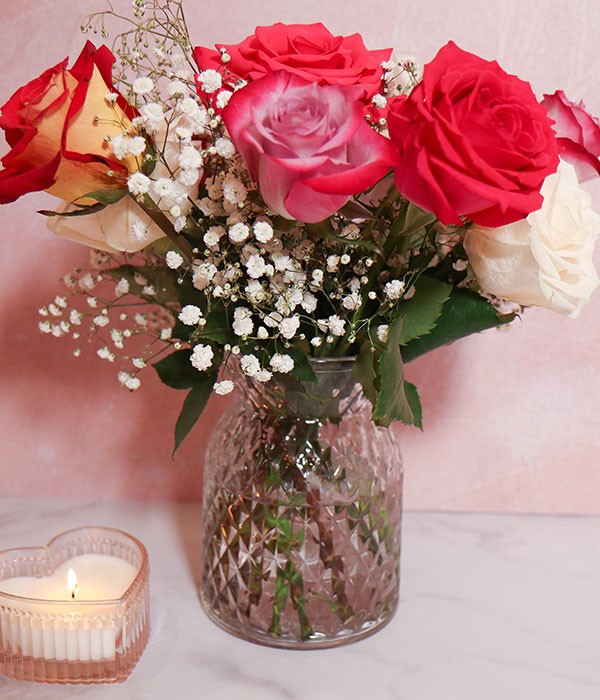Roses, with their velvety petals and captivating fragrances, are timeless symbols of love, appreciation, and beauty. Receiving a bouquet of roses is a delightful experience, and with the right care, you can prolong their fresh-cut charm and enjoy their splendor for an extended period. As floral experts, we’re sharing our top tips on how to care for roses in a vase, ensuring your blooms remain vibrant and beautiful.
10 Expert Tips to Keep Your Roses Fresh and Vibrant
1. Warmth During Transport: Protecting Roses from the Cold
When you purchase cut roses, especially during colder seasons, it’s crucial to shield them from temperature shocks right from the start. Florists typically provide protective floral bags, and these are excellent for safeguarding your roses as you transport them from the store to your car. However, if the temperature dips below 33°F (0°C), avoid leaving your roses in a cold car for prolonged periods. Extreme cold can damage the delicate petals and buds, hindering their ability to hydrate properly once placed in a vase. Treat them like you would any other sensitive item during freezing temperatures – bring them indoors as soon as possible.
2. Quick Hydration is Key: Getting Roses into Water Promptly
Time is of the essence when it comes to hydrating fresh-cut roses. After leaving the floral department, your roses have a limited window to be placed back in water before they start to dehydrate. Depending on the ambient temperature, this critical period is roughly 1-3 hours. The sooner you can get your roses into a vase filled with fresh water, the better their chances of a long and vibrant vase life. Dehydration stress can significantly shorten their lifespan and cause premature wilting.
3. Start with a Spotless Vase: The Foundation for Healthy Blooms
The vase you choose is more than just a container; it’s the home for your roses. Ensuring it’s immaculately clean is a fundamental step in rose care. Bacteria buildup in vases can contaminate the water and quickly degrade your flowers. While various cleaning methods exist, a simple and effective approach involves using a mild bleach solution and liquid dish soap. Wash the vase thoroughly with soapy water, rinse it well, and then sanitize it with a diluted bleach solution (a tablespoon of bleach per gallon of water). This will eliminate any lingering bacteria and create a pristine environment for your roses.
4. Leaf Management Below Waterline: Preventing Bacterial Growth
Once you’ve unwrapped your bouquet, take a moment to inspect the stems. Identify and carefully remove any leaves that would fall below the waterline once the roses are placed in the vase. Submerged leaves decompose in water, becoming breeding grounds for bacteria. This bacterial growth not only clouds the water but also releases harmful substances that can clog the roses’ stems and impede water absorption, leading to a shorter vase life and potentially causing the roses to wilt prematurely. Removing these leaves is a simple yet highly effective way to maintain water purity and promote the longevity of your roses.
5. The Right Water and Nourishment Balance: Flower Food and Hydration
The amount of water you add to your vase should be carefully considered, especially in relation to the flower food provided. Bouquets from reputable florists, like Heinen’s, often include flower food packets specifically formulated to nourish roses. Always read the instructions on the flower food packet, as the concentration varies; sometimes, a single packet is designed for only a pint of water. A general recommendation is to fill your vase to about ½ to ¾ full with cool, fresh water.
While homemade flower food “remedies” such as soda, vodka, or 7UP circulate, we advise against using them. Scientifically formulated flower food packets contain the precise nutrients and biocides needed to extend the life of your roses effectively. If you happen to run out of flower food packets, a temporary DIY solution can be made by adding a single drop (or ¼ teaspoon) of bleach and a tablespoon of sugar to your vase water. The bleach acts as a bactericide, while sugar provides a minimal energy source. However, for optimal and consistent results, using commercial flower food is always recommended.
6. The Art of Fresh Cutting: Preparing Stems for Hydration
After preparing your vase with water and flower food, the next crucial step is to give your rose stems a fresh cut. Immediately after cutting, place the stems into the prepared vase water. You have a brief window of approximately 10 seconds to get each stem into water before the cut end begins to seal itself. This rapid sealing is a natural defense mechanism in plants, but it can trap air bubbles in the stem if water uptake is delayed. These air bubbles can block the water-conducting vessels, leading to poor hydration and wilting.
Using the right tool for cutting is also essential. Ordinary household scissors are often too blunt and can crush the stems, damaging the water-conducting tissues. Instead, opt for a very sharp knife or garden pruners. Make the cut at an angle; an angled cut increases the surface area for water absorption compared to a straight cut.
7. Daily Water Refreshment: Maintaining Water Quality and Hydration
Changing the vase water daily is a cornerstone of rose care. Think of the vase water as you would drinking water – if it doesn’t look or smell fresh enough for you to drink, it’s definitely not suitable for your flowers. Daily water changes prevent bacterial buildup and ensure the roses have access to clean, hydrating water.
Each time you change the water, it’s beneficial to give your rose stems another fresh cut, removing a small portion from the bottom. This helps to prevent blockage and encourages continuous water uptake. Remember to add a fresh packet of flower food (or replenish your DIY solution) with each water change to provide consistent nourishment.
8. Shield from Temperature Extremes: Creating the Ideal Environment
To maximize the vase life of your roses, position them in the coolest area of your home, away from direct sunlight, strong drafts, and heat sources. Excessive heat will accelerate water loss and cause the roses to wilt quickly. Similarly, direct sunlight can overheat the blooms and fade their colors. Avoid placing roses near vents from air conditioners or heaters, as these temperature fluctuations can be detrimental.
Another often-overlooked factor is ethylene gas. Fruits, especially ripening fruits like bananas and apples, emit ethylene, a plant hormone that accelerates ripening and aging in flowers. Keep your roses away from fruit bowls and fruit-producing plants to prevent premature wilting and browning.
9. Guard Petals – To Remove or Not?: Understanding Protective Petals
Guard petals are the outermost petals on a rose bloom. They are sometimes greenish or have slight brown edges. These petals serve as natural protectors for the more delicate inner petals during the rose’s development and transportation. It’s generally best to leave guard petals in place until the day you intend to use the roses in a floral arrangement or want them to look their absolute best for display. Removing them prematurely can shorten the overall lifespan of the rose, as they provide a layer of protection and support to the more vulnerable inner petals. If you prefer a cleaner look for your roses, you can gently remove the guard petals just before showcasing them.
10. Vigilant Rose Observation: Recognizing Signs and Reacting
While proper care significantly extends the life of roses, they are still perishable items. Typically, roses in a vase will last between 5-7 days, but with exceptional care, some varieties can even last up to 2 weeks. Keep a close eye on your roses. If they start to look droopy, wilted, or “sad,” it’s a signal that they need immediate attention.
The first step is to change the vase water, adding fresh flower food solution and re-cutting the stems. Often, this simple revival treatment will perk them up within 2-3 hours. If they don’t improve, consider repositioning them to a cooler, darker location. Consistent observation and prompt action are key to enjoying your roses for as long as possible.
By following these expert tips, you can confidently care for your roses in a vase, ensuring they remain a beautiful and vibrant focal point in your home for many days to come. Enjoy the lasting beauty of your roses!

